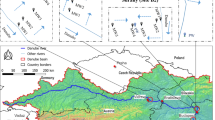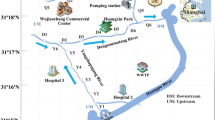Abstract
Purpose
The Llobregat River, which is characterized by important fluctuations of the flow rates, receives treated waters from WWTPs. During the years 2007 and 2008, the Llobregat River basin suffered from a severe drought which affected the supply of drinking water facilities (DWF) that rely on the exploitation of the river water. The Catalan Water Agency implemented a water reuse experiment with the objective of maintaining the river flow rate at sufficiently high level so as to ensure the supply of raw water to Barcelona’s major DWF.
Method
A total of 103 emerging contaminants belonging to the groups of pharmaceuticals (74), illicit drugs (17) and oestrogens (12) were determined using LC-MS/MS methods in river water samples during the water reuse campaign. The effect of the reclaimed water discharge on the river water quality, in terms of contamination loads and environmental risk (based on the concentration addition mode), is discussed.
Results
Fifty-eight pharmaceuticals out of 74 monitored were detected at least in one sample. In river water upstream (site R0) majority of compounds were detected at low nanograms per litre levels, while downstream of discharge of tertiary effluent only few compounds were detected at levels higher than 100 ng L−1 (i.e. acetaminophen, diclofenac, erythromycin, sulfamethazine), but never exceeding 500 ng L−1. The total concentration of illicit drugs was found to be very low at both sampling sites (<50 ng L−1). No relevant ecotoxicity risks were identified, except for pharmaceuticals vs. algae.
Conclusions
In general, the discharge of reclaimed water in the river influenced perceptibly in terms of concentrations, mass loads and environmental risk, especially for pharmaceuticals and in less extent for illicit drugs. Nevertheless, it was not very significant in any case.








Similar content being viewed by others
References
Aggeli K, Kalavrouziotis IK, Bezergianni S (2009) A proposal of a treated wastewater reuse design system in urban areas. Fresenius Environmental Bulletin 18(7):1295–1301
Andreozzi R, Marotta R, Pinto G, Pollio A (2002) Carbamazepine in water: persistence in the environment, ozonation treatment and preliminary assessment on algal toxicity. Water Res 36(11):2869–2877
Azar MN, Sharvelle S, Stromberger M, Roesner L (2010) Long-term effects of graywater irrigation on soil quality in arid regions. In: World Environmental and Water Resources Congress 2010: Challenges of Change - Proceedings of the World Environmental and Water Resources Congress 2010, pp 4109–4117
Backhaus T (2011) Interactions and their impact on the applicability of concentration addition for environmental realistic mixtures., vol RA10-3 SETAC EUROPE 21st Annual Meeting Abstract Book. Milan
Barceló D, Petrovic M (2007) Emerging contaminants in wastewaters. TrAC - Trends Anal Chem 26(11):1019
Batt AL, Kim S, Aga DS (2007) Comparison of the occurrence of antibiotics in four full-scale wastewater treatment plants with varying designs and operations. Chemosphere 68(3):428–435
Bliss CI (1939) The toxicity of poisons applied jointly. Ann Appl Biol 26(3):585–615
Cazurra T (2008) Water reuse of south Barcelona's wastewater reclamation plant. Desalination 218(1–3):43–51
Chefetz B, Mualem T, Ben-Ari J (2008) Sorption and mobility of pharmaceutical compounds in soil irrigated with reclaimed wastewater. Chemosphere 73(8):1335–1343
Chiron S, Minero C, Vione D (2006) Photodegradation processes of the antiepileptic drug carbamazepine, relevant to estuarine waters. Environ Sci Technol 40(19):5977–5983
Dombeck G, Borg C (2005) An integrated oxidation-reduction platform for disinfection, microcontaminant destruction and nutrient removal. In: 2005 ASAE Annual International Meeting
Exall K (2004) A review of water reuse and recycling, with reference to Canadian practice and potential: 2. Applications. Water Qual Res J Can 39(1):13–28
Farré M, Ferrer I, Ginebreda A, Figueras M, Olivella L, Tirapu L, Vilanova M, Barceló D (2001) Determination of drugs in surface water and wastewater samples by liquid chromatography-mass spectrometry: methods and preliminary results including toxicity studies with Vibrio fischeri. J Chromatogr A 938(1–2):187–197
Ghermandi A, Bixio D, Thoeye C (2007) The role of free water surface constructed wetlands as polishing step in municipal wastewater reclamation and reuse. Sci Total Environ 380(1–3):247–258
Ginebreda A, Muñoz I, de Alda ML, Brix R, López-Doval J, Barceló D (2010) Environmental risk assessment of pharmaceuticals in rivers: relationships between hazard indexes and aquatic macroinvertebrate diversity indexes in the Llobregat River (NE Spain). Environ Int 36(2):153–162
Grung M, Källqvist T, Sakshaug S, Skurtveit S, Thomas KV (2008) Environmental assessment of Norwegian priority pharmaceuticals based on the EMEA guideline. Ecotoxicol Environ Saf 71(2):328–340
Hansen PD, Dizer H, Hock B, Marx A, Sherry J, McMaster M, Blaise C (1998) Vitellogenin - a biomarker for endocrine disruptors. TrAC - Trends Anal Chem 17(7):448–451
Huschek G, Hansen PD, Maurer HH, Krengel D, Kayser A (2004) Environmental risk assesssment of medicinal products for human use according to European Commission recommendations. Environ Toxicol 19(3):226–240
Kasprzyk-Hordern B, Dinsdale RM, Guwy AJ (2009) The removal of pharmaceuticals, personal care products, endocrine disruptors and illicit drugs during wastewater treatment and its impact on the quality of receiving waters. Water Res 43(2):363–380
Kim Y, Choi K, Jung J, Park S, Kim PG, Park J (2007) Aquatic toxicity of acetaminophen, carbamazepine, cimetidine, diltiazem and six major sulfonamides, and their potential ecological risks in Korea. Environ Int 33(3):370–375
Köck-Schulmeyer M, Ginebreda A, Postigo C, López-Serna R, Pérez S, Brix R, Llorca M, Alda MLD, Petrović M, Munné A, Tirapu L, Barceló D (2010) Wastewater reuse in Mediterranean semi-arid areas: the impact of discharges of tertiary treated sewage on the load of polar micro pollutants in the Llobregat river (NE Spain). Chemosphere 82(5):670–678
Kuster M, López de Alda MJ, Hernando MD, Petrovic M, Martín-Alonso J, Barceló D (2008) Analysis and occurrence of pharmaceuticals, estrogens, progestogens and polar pesticides in sewage treatment plant effluents, river water and drinking water in the Llobregat river basin (Barcelona, Spain). J Hydrol 358(1–2):112–123
López-Serna R, Pérez S, Ginebreda A, Petrović M, Barceló D (2010) Fully automated determination of 74 pharmaceuticals in environmental and waste waters by online solid phase extraction-liquid chromatography- electrospray-tandem mass spectrometry. Talanta 83(2):410–424
Markus MR, Deshmukh SS (2010) An innovative approach to water supply - The groundwater replenishment system. In: World Environmental and Water Resources Congress 2010: Challenges of Change - Proceedings of the World Environmental and Water Resources Congress 2010, 3624–3639
Matamoros V, Hijosa M, Bayona JM (2009) Assessment of the pharmaceutical active compounds removal in wastewater treatment systems at enantiomeric level. Ibuprofen and naproxen. Chemosphere 75(2):200–205
Mujeriego R, Compte J, Cazurra T, Gullón M (2008) The water reclamation and reuse project of El Prat de Llobregat, Barcelona, Spain. Water Science and Technology, vol 57
Muñoz I, Gómez-Ramos MJ, Agüera A, Fernández-Alba AR, García-Reyes JF, Molina-Díaz A (2009a) Chemical evaluation of contaminants in wastewater effluents and the environmental risk of reusing effluents in agriculture. TrAC - Trends in Analytical Chemistry 28(6):676–694
Muñoz I, López-Doval JC, Ricart M, Villagrasa M, Brix R, Geiszinger A, Ginebreda A, Guasch H, López De Alda MJ, Romaní AM, Sabater S, Barceló D (2009b) Bridging levels of pharmaceuticals in river water with biological community structure in the Llobregat river basin (northeast Spain). Environmental Toxicology and Chemistry 28(12):2706–2714
Nakada N, Kiri K, Shinohara H, Harada A, Kuroda K, Takizawa S, Takada H (2008) Evaluation of pharmaceuticals and personal care products as water-soluble molecular markers of sewage. Environmental Science and Technology 42(17):6347–6353
Nakada N, Tanishima T, Shinohara H, Kiri K, Takada H (2006) Pharmaceutical chemicals and endocrine disrupters in municipal wastewater in Tokyo and their removal during activated sludge treatment. Water Research 40(17):3297–3303
Pérez S, Barceló D (2008) First evidence for occurrence of hydroxylated human metabolites of diclofenac and aceclofenac in wastewater using QqLIT-MS and QqTOF-MS. Analytical Chemistry 80(21):8135–8145
Petrovic M, Solé M, López de Alda MJ, Barceló D (2002) Endocrine disruptors in sewage treatment plants, receiving river waters, and sediments: Integration of chemical analysis and biological effects on feral carp. Environmental Toxicology and Chemistry 21(10):2146–2156
Postigo C, Lopez De Alda MJ, Barceló D (2008) Fully automated determination in the low nanogram per liter level of different classes of drugs of abuse in sewage water by on-line solid-phase extraction-liquid chromatography-electrospray-tandem mass spectrometry. Analytical Chemistry 80(9):3123–3134
Purdom CE, Hardiman PA, Bye VJ, Eno NC, Tyler CR, Sumpter JP (1994) Estrogenic effects of effluents from sewage treatment works. Chemistry and Ecology 8:275–285
Rodriguez-Mozaz S, Lopez De Alda MJ, Barceló D (2005) Picogram per liter level determination of estrogens in natural waters and waterworks by a fully automated on-line solid-phase extraction-liquid chromatography-electrospray tandem mass spectrometry method. Analytical Chemistry 76(23):6998–7006
Sanderson H, Johnson DJ, Wilson CJ, Brain RA, Solomon KR (2003) Probabilistic hazard assessment of environmentally occurring pharmaceuticals toxicity to fish, daphnids and algae by ECOSAR screening. Toxicology Letters 144(3):383–395
Santos LHMLM, Araújo AN, Fachini A, Pena A, Delerue-Matos C, Montenegro MCBSM (2010) Ecotoxicological aspects related to the presence of pharmaceuticals in the aquatic environment. Journal of Hazardous Materials 175(1–3):45–95
Scheytt TJ, Mersmann P, Heberer T (2006) Mobility of pharmaceuticals carbamazepine, diclofenac, ibuprofen, and propyphenazone in miscible-displacement experiments. Journal of Contaminant Hydrology 83(1–2):53–69
Spanish Government, 2007. Real Decreto 1620/2007, de 7 de diciembre, por el que se establece el régimen jurídico de la reutilización de las aguas depuradas. Boletín Oficial del Estado, 294:50639
Sprague JB, Ramsay BA (1965) Lethal Levels of Mixed Copper–Zinc Solutions for Juvenile Salmon. Journal of the Fisheries Research Board of Canada 22(2):425–432
Wintgens T, Salehi F, Hochstrat R, Melin T (2008) Emerging contaminants and treatment options in water recycling for indirect potable use. Water Science and Technology, vol 57
Xu J, Chen W, Wu L, Green R, Chang AC (2009) Leachability of some emerging contaminants in reclaimed municipal wastewater-irrigated turf grass fields. Environmental Toxicology and Chemistry 28(9):1842–1850
Acknowledgements
This work has been supported by the Catalan Water Agency, the Spanish Ministry of Science and Innovation [projects Cemagua CGL2007-64551/HID and Consolider-Ingenio 2010 Scarce CSD2009-00065]. Merck is acknowledged for the gift of LC columns and Spark Holland for the gift of online SPE cartridges. RLS acknowledges the Spanish Ministry of Education and Science for the economical support through the FPI pre-doctoral grant. CP acknowledges AGAUR (Generalitat de Catalunya, Spain) for their economical support through the FI pre-doctoral grant. SP acknowledges the contract from the Ramón y Cajal Program of the Spanish Ministry of Science and Innovation.
Author information
Authors and Affiliations
Corresponding author
Additional information
Responsible editor: Henner Hollert
Rights and permissions
About this article
Cite this article
López-Serna, R., Postigo, C., Blanco, J. et al. Assessing the effects of tertiary treated wastewater reuse on the presence emerging contaminants in a Mediterranean river (Llobregat, NE Spain). Environ Sci Pollut Res 19, 1000–1012 (2012). https://doi.org/10.1007/s11356-011-0596-z
Received:
Accepted:
Published:
Issue Date:
DOI: https://doi.org/10.1007/s11356-011-0596-z




